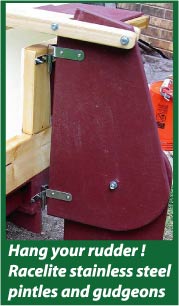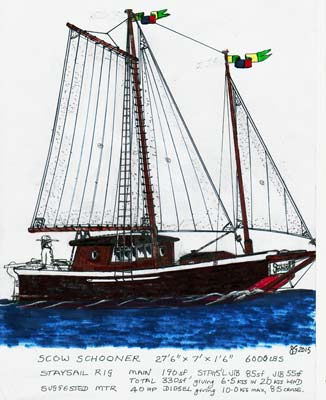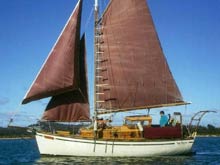
 Custom Search
|
| boat plans |
| canoe/kayak |
| electrical |
| epoxy/supplies |
| fasteners |
| gear |
| gift certificates |
| hardware |
| hatches/deckplates |
| media |
| paint/varnish |
| rope/line |
| rowing/sculling |
| sailmaking |
| sails |
| tools |
| join |
| home |
| indexes |
| classifieds |
| calendar |
| archives |
| about |
| links |
| Join Duckworks Get free newsletter CLICK HERE |
|
|
| Scouser 27 - Part One |
by Jeff Gilbert - Darby, Tasmania - Australia |
Part One - Part TwoOcean-capable Coasting Staysail Scow Schooner27' 5" LOD, 25ft LWL x Beam 7ft x Draught 1'6" Transom 5 ft beam, bow 4 ft beam.
The search goes on for a boat that seems worth the effort and considerable cost of building. Much is against the erstwhile builder, whether they be a teenager, retiree, or something in between. Their enthusiasm is tempered by the scale of the task, the cost of materials spiralling and the cost of a decent building environment is spiralling also. What is left of one's keenness may be blunted by the glut of cheap seaworthy well-built second-hand boats on the market. There are several beautifully built less than 20 year old wooden gaff cutters in the 25ft LOD range available in Australia for $US 11-20k, inch carvel planked on Tasmanian hardwood frames, tan canvas rigs, two berths and salty as a barrel of cod. For example the 25ft on deck Gaff Cutter below, launched in 1996 and fitted with a 23HP marine diesel, is yours for US $19,000, see boatsales.com.au , if it hasn't sold already.
But don't despair of ever achieving the ultimate thrill: taking to the briny in a boat you built yourself. What a buzz! Longer-lasting than sky-diving, that's for sure. Many of us did it as kids, in my case a roofing iron canoe with an apple-box transom sealed with tar scraped from the side of the road on a hot day, and heated in an old paint tin over a fire. No-one drowned, and we caught a lot of eels. But to go the extra miles to build a boat that can take on the heaving ocean, you need to get a design that you so enjoy that you actually dream about it, want to know more about it and no other boat will quite do. You don't care what reaction your friends may have to it. The length of a boat-building project can be its saving grace. I know many blokes who could have built a fine little craft in the time they spent watching Cricket in the last 5 years, funding the boat with the money they drank in beer. Which would have given the most satisfaction? Watching Australia beat or be thrashed by the West Indies just makes me wish I was sailing in Antigua with the Cricket ground receding from sight and memory over the transom. Don't get me wrong, Cricket is a fine game, smacking of fair play and decency. But, even in retirement, I can't find 5 days to sit down and watch a Test match unfold. Retirement is a time when one wonders how the hell one found time to work! Planning for retirement is a nightmare. If you think too much about money, there's never enough. If you don't consider money at all, there's never enough. My plan is simple. When you've had a gut-full, work 5 years more at an easy steady pace, not seeking advancement and making it clear that you are not up for brownie points by working unpaid overtime. Look after your Personnel people, attend their birthdays and show them that you appreciate the work they do for you, often under high pressure deadlines. (When it comes to retirement management, they can really help. Over-stressed when I left, they awarded me all my sick leave.) Drive a reliable old bomb and throw every penny you can at whatever employer-backed super plan your firm has, preferably a fully funded nonprofit employee benefit. Don't go near any super scheme staffed out of profits. When the five years is up, tell the Boss what you really think. This guarantees a smooth and speedy exit, but doesn't apply if you need post-retirement work. Don't respond to "early retirement" bonuses, they always calculate out badly in the long run. They are only offered in the hope you'll take a mesmerising carrot now instead of collecting 3 later. Like a donkey. I still think its best to break free and clear, leaving the area and any temptation to return to what you know so well it makes you sick. Even if you need money. I'd rather work as a barman than return to what I did for 23 years. No-one in their right mind can last much longer in a modern office, replete as they are with air conditioning, do-gooders and fanatic nit-pickers. I digress, its simply that being a retiree, I tend to think of boats and issues that pertain to retirees, a stage of life where you've left too late unless you eat well and exercise sans excess. Its a sad truth that unless one lives aboard, few can afford a boat till they are almost too old to enjoy it. Hence the glut of white-knuckled, white-haired motorbike/powerboat pilots. In 2015 the only way one can raise and maintain the enthusiasm to build a first boat is to tackle the problems head on. Thus you'll need a design that:
This last may not be important to some, but to many builders it is the stamp that makes the whole project worthwhile, and it often involves a leap of faith, by trusting a lesser known designer, but do stick to one who sticks to first principles (no-one wants the best wheelhouse view in the world if the craft is unstable. Designing "outside the envelope" shouldn't mean outside the envelopes of safety and structural strength). "Putting your faith in" is a little strong, its really about spending $80 to $200 on some plans, which is little enough that you don't feel as financially obliged to build as you would be if you spent the $7000 some of our more famous catamaran designers command. At the low price you could even have a check done, but rest assured that if a designer publishes a figure its checked. That doesn't mean designers are immune from typos or transpositions, the usual cause of wrong numbers on a plan. If you don't want to build, pin the plan up somewhere, it might grow on you. Profiles and sail plans look well on an office or study wall. Besides, I'm certain you'll learn your money's worth by studying the plans with a view to build and a good building book plus the materials list to hand. (You may find you already have a surprising amount of timber if one tends to over-buy and store top quality building materials. The point is if you buy something good for a project, get extra as the next batch at your outlet is often not the exact same size or quality.) A year spent quietly assembling wood and tools whilst convinced not to build could change your mind. You could build a rudder and see how you like it. Carve the stock by a winter fire. I sketched up Scouser as a unique boat, attracted by this alone. I soon found it fits the dot-point list above rather well. The design was inspired by the robust 40-odd-foot coasting timber-carrying scow schooners of Auckland, which had disappeared as working boats, well and truly replaced by trucks by the time I moved there to study maths in 1970. Mostly they carried sawn Kauri planks from North Auckland sawmills to the furniture, home and boat-building businesses of New Zealand's biggest city which nestles between both East and West coast harbours. Most New Zealand housing is built in timber as it will generally withstand the earthquakes common to NZ, the "Shaky Isles". When available, NZ Kauri rated as Australasia's second most preferred planking timber behind Tasmania's Huon pine. Due to enthusiastic logging, unobstructed by any kind of resource management plan, both are now all but extinct and their harvesting rigidly controlled. The gate has been double-locked now that the horse has bolted. Nevertheless boats planked in these rot-resistant timbers sail on, some over 100 years old. I also looked closely at Phil Bolger's 28 x 10 foot scow schooner (see Boats with an Open Mind) - a pocket coasting version of the hay-carting Northern California schooners. None have been built s yet , perhaps because of the two aspects I found not to my taste, the short 19 foot Waterline length and the engine power provided by a "Push boat." Phil's design is worthy of study and a very attractive extension of the type. My idea is smaller, mainly in beam, because I couldn't resist the idea of a boat that could be container-hauled, trucked or even towed to the upper reaches of the world's great river and canal systems, with some degree of cost-effectiveness. The chance to cruise the Nile doesn't crop up chatting over the back fence, especially if you don't have one Scouser is 25 feet on the WL and can be powered by a range of engines - preferably a 40-200HP outboard geared at over 2 to one, or a stern drive unit. A full inboard, could, I fear, turn the boats best feature, its walk-through accommodations, into an obstacle course. However, an imaginative builder could find a way to fit a small unit in, (perhaps in the stern with a V shaft arrangement, perhaps in the mid-cockpit), and it would be highly efficient with a shaft near-parallel to the waterline and a slow-turning 3-bladed high pitch prop. For example, a Westerbeke or Perkins 40HP with a 2 to 1 reduction would cruise Scouser at a handy 8 knots with an hourly diesel burn of under 2 US gallons. A "Scouser', apart from playing on "Scow Schooner", is slang for a Liverpool Resident, whose distinctive English dialect became known worldwide via the Beatles. I'm not poking fun at Liverpudlians, but rather honouring them as they made up many of Britain's Merchant Marine during the dark days of the early 1940's, when the German U-boat Wolf Packs preyed upon convoys of helpless Transatlantic tankers and freighters in frightening numbers.
These sailors probably assumed themselves awaiting a torpedo until they steamed up the Mersey, and sighted saw the famous Liver Birds statue adorning the Royal Assurance Building of 1911, and realised they had beaten the odds. This time. How does Scouser fit the criteria for a worthwhile build? Simple to BuildMost reading this will have built a shed, or framed a wall. This leads to the possibility of a houseboat - pleasant to be aboard until you need to maintain a course. Pop the houseboat cabin within a landing craft and you are halfway there. Build a scow schooner and can have it all - simplicity of build, low-slung good looks, stability, and a surprising level of performance for your dollar. Easily Obtained ToolsTools are self explanatory, the boat being small enough to build with hand tools although obviously an electric socket in your shed is something that, in 2015, you wouldn't want to be without. Warning:- without being rude, if you don't already have many of these tools you are unlikely to have as yet developed the skills to build such a boat. Build a small garden shed first, and/or recruit your Dad! Most parents would rather see their children building a boat than hunting apexes in a fast car. If you have a basic set of tools buy the rest as you need them. If its too expensive, try to do without. Borrowing uses up petrol and favours very quickly. Before borrowing a tool, examine very carefully how you feel about lending yours out. Buying is just a matter of weighing what you have to do, and how accurately, and how often against price and alternatives. I'll attempt a list. Band saws and table saws are a luxury for small craft. I'm bound to have missed something. A PRETTY GOOD TOOL SET:
LUXURY TOOLSA wood stove in your shed A helper who isn't in it for the money. Car jack(s) and pulleys (for turning hull from floor/rafters)/ Available MaterialsScouser, built with ply-epoxy over frame and stringer construction, is as cheap as it gets with longevity largely a result of a thorough approach to coatings and fixings, especially edge-coating of ply, whether its exposed or not. While Beuhler's excellent book on plank/ply on frame style boat building describes an interesting possibility of using cheaper sign-writing ply with one good face, expensive marine ply will always pay of in any long-term ownership and/or resale, especially if the boat is a keeper beyond the years when you'll want to sand it back and paint it yourself every few years. That said, you probably know by now that amateur boat building is a labour of love, an ultimate link between you and the sea, not a money-making exercise unless you are able to bring the speed that comes with a decade's experience, and a wide open Client's chequebook, to bear. If you wish to building on spec., stick to houses. The same book also describes a homespun method of preserving untreated timber boats. The method sound effective, if a little toxic by modern standards. But you don't want to be squeamish about preserving wood. Anything effective is pretty toxic. Protect your lungs and skin and remember that you are preserving forest by preserving cut timber. As I write I have a lot of hardwood stacked about my property, and wish I had built my (soon to complete) shed 10 years ago. (Aside: I was surprised to find that my steel kitset shed (40 x 18 x 16 feet at gable peak) was cheaper at $A10,500 (say 7000 US) than I was quoted in 2009. I hope the same applies overseas.) If you are thinking of building, consider building a shed while you are thinking. Install a bench and a wood stove. Lay down a keel or a stack of wood fast before the shed obeys some unfathomable natural law and fills itself with old broken cars, vacuum cleaners and computers. Remember that a shed gives you the power to buy and store quality hardwood, which these days is a better investment than gold. You can buy green lumber and dry it in the roof frames - watch and turn it though. Naturally dried is stronger and ultimately cheaper than kiln dried. Study the cuts of lumber and try to avoid buying anything that wants to cup - there are lots of saw-millers where I live and I've learned a lot from them over an ale or two. They are proud of their knowledge and have learned which local timbers last by watching the slow demise of unclaimed orders lying stacked in the weather, the covers blown off many winters ago. If thinking of buying, if there is any rot, discard the lot except of course if there is a plain reason such as the bottom planks lying direct on the ground. Remember when buying small lots that boatbuilding is a speciality use and any old knotty bit won't do - you need to inspect the lot unless paying a premium from a specialized boat timber retailer. Millers still give cash discounts but around here retailers have stopped doing so - ten years ago I had 25 percent off for my verandah wood, now its zero with a huge price hike to boot. Some retailers around here are offering Chenchen Chinese waterproof-glued ply with one good face for about 40pct of the price of marine - I've yet to hear of anyone building a boat out of it and wonder if its turned up Stateside? |
To comment on Duckworks articles, please visit one of the following:
|
 |






